Stuart Forster travels to Baden-Württemberg’s state capital and visits the SchweineMuseum Stuttgart, Germany’s Pig Museum.
Disclosure: Some of the links below and banners are affiliate links, meaning, at no additional cost to you, I will earn a commission if you click through and make a purchase.
The bus running in the direction of Stuttgart’s Schlachthof is up ahead. Just as I think it’s about to pull away without me the door swishes open. The driver bids me to step aboard. “Ich habe Schwein gehabt!” as they say in this part of the world, meaning ‘I was lucky’.
I’m on my way to Germany’s Pig Museum, the SchweineMuseum Stuttgart. The visitor attraction is housed in a building dating from 1909. Germany’s interpretation of Art Nouveau, Jugendstil, influenced the design of the building, which formerly served as the administrative building of Stuttgart’s Old Slaughterhouse. Butchering on the 12-hectare site ceased back in 1992 and the admin building was converted to hold apartments. Stuttgart’s SchweineMuseum opened in May 2010.
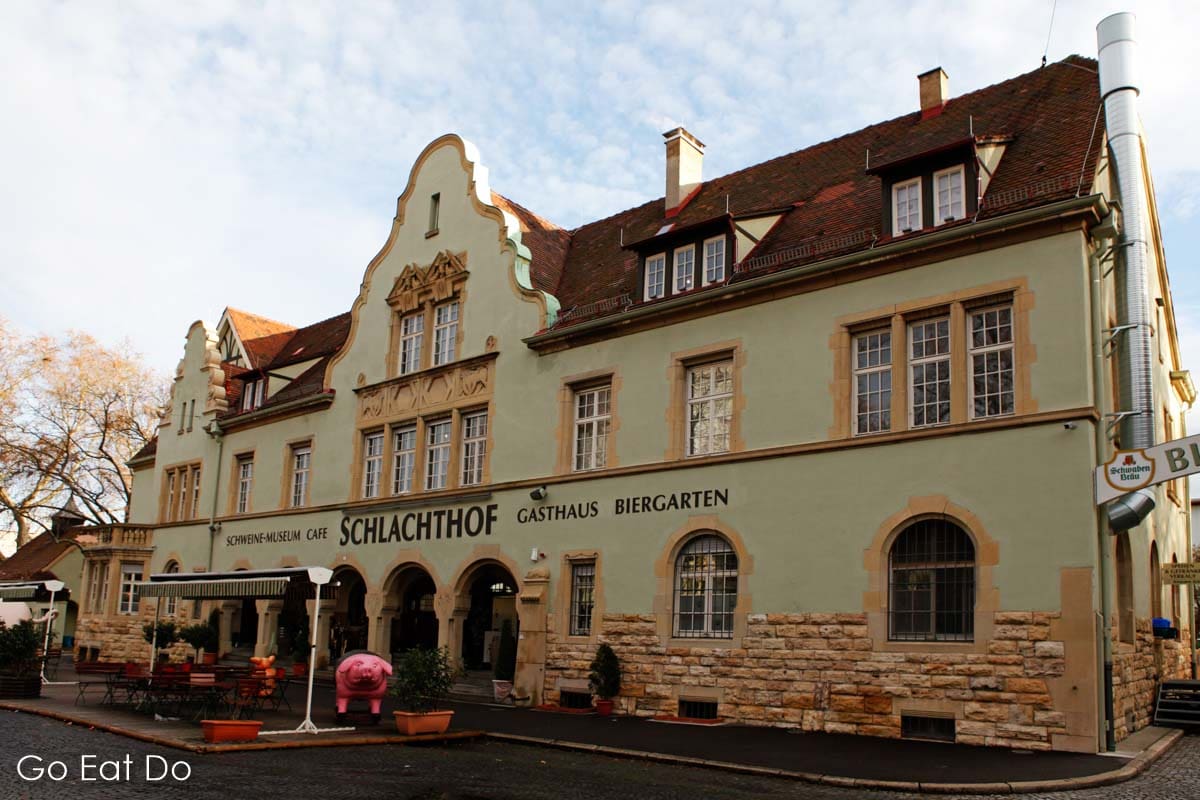
The Pig Museum in Germany
The attraction I’ve come to see is run by Erika Wilhelmer, who’s also the proprietor of the Stuttgart Schlachthof bar and restaurant. I glance at a menu and note that schnitzel made from pork and roast Schweinehaxe (pork knuckle) count among the traditional German dishes served. Maultaschen (a version of meat-filled pasta) and Käsespätzle (cheesy hand-rubbed noodles) count among the menu’s regional Swabian dishes.
“The slaughterhouse itself was torn down,” Erika explains, when we begin chatting in German.
Erika previously ran a museum at Bad Wimpfen on Lake Constance. Then she started collecting the pigs that are today displayed in the SchweineMuseum Stuttgart’s 27 themed rooms. The attraction proudly proclaims its status as ‘the largest pig museum in the world.’
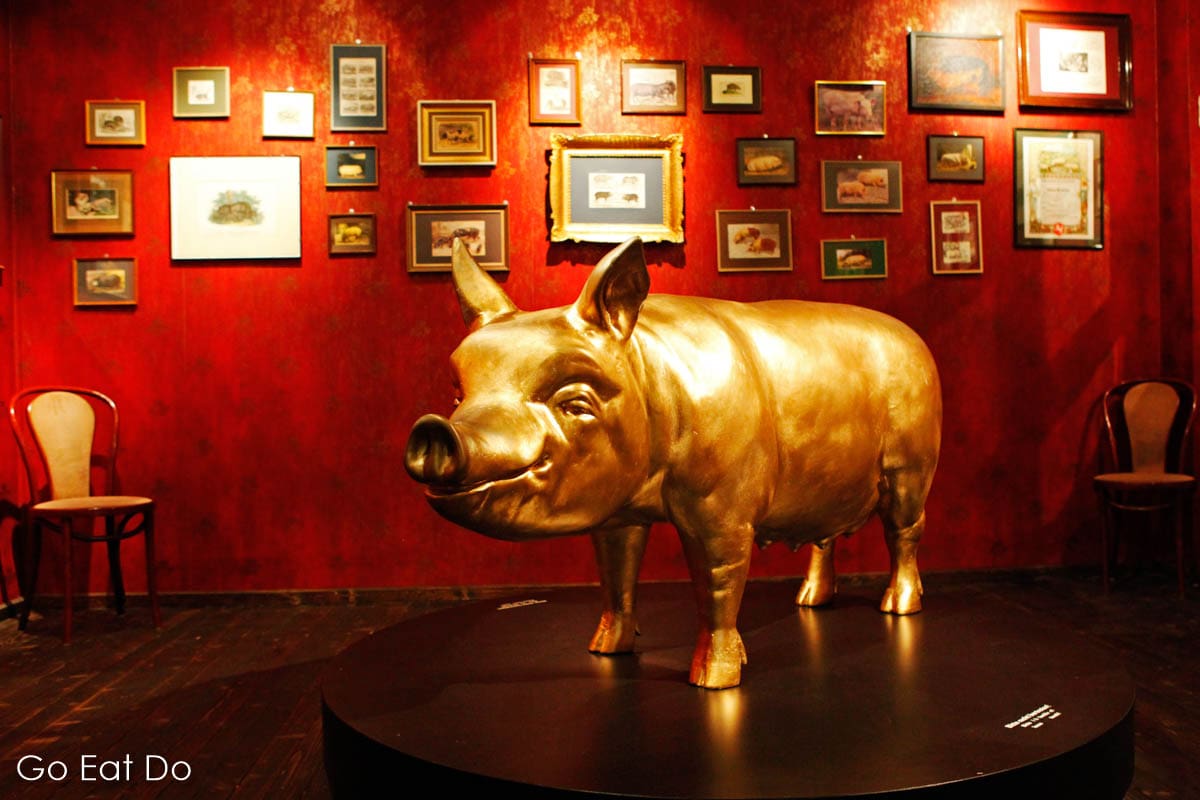
Origins of the SchweineMuseum Stuttgart
“I collected totally different things then had a guest with me who collected pigs. I brought her a little Miss Piggy from the market but I didn’t want to give it away. It was very pretty; it was painted, really beautiful. I had no idea then there were antiques,” recalls Erika. Her collection grew quickly.
“She had 200. The kitchen, bath and living room were full of pigs. I overtook her in the first year. I had 600. She was shirty with me,” recalls Erika laughing.
“Visitors made an effort. They brought me pigs every now and again and the collection got going. I bought them up at flea markets too. I still go to markets but there are far fewer antiques, I get hold of them from dealers. They seek them out for me.”

So are there any major gaps in her collection? Nothing major it seems. Then Erika pauses and says, “I’m missing a bit from France. In Belgium I got a few but it’s become tricky.”
Do any of the pigs stand out, I wonder?
“I have hundreds of favourites,” says the museum’s owner. “Those that are sauteuer [a term meaning ‘very expensive’ and a play on the word ‘sow’ that has no direct translation in English] and saugut [meaning ‘really good’]. I love each one. I have kitsch, for sure. I’ve also received whole collections from people who didn’t want them anymore.”
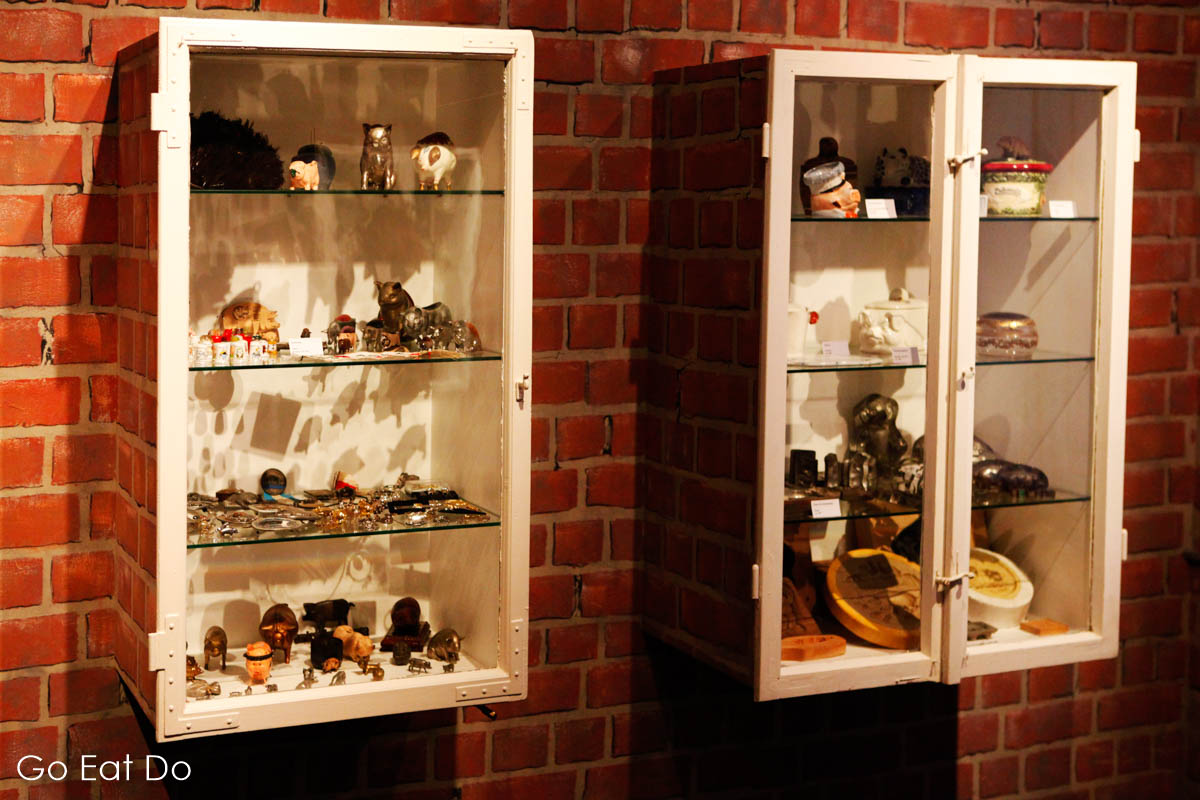
The world’s biggest pig museum
Erika offers a home to a surprising number of little piggies. “We have about 50,000 now. The whole third floor of the museum is packed full of pigs. We try to categorise them – glass to glass and metal to metal, and so on – but there are a few that don’t fit. We change our collection around every now and again and that pleases repeat visitors, when they see something they haven’t already,” she says before I head off to explore the exhibits.
The museum’s strapline is Kunst, Kultur und Kitsch meaning ‘art, culture and kitsch’. Exhibits include informative, scientific-style displays that provide information about the development of piglets in the sow’s womb and facts about the consumption of pork. They extend to witty arrangements providing information on how language has been influenced by pigs. I felt as happy as a pig in muck while looking around.
I learn that in 2010 the average German ate 56 kilograms (123 pounds) of pork. Since the 1950s consumers have demanded meat with less fat and that has resulted in changes to the breeds kept on many farms.
Perhaps surprisingly, it seems that nobody knows definitively how many pig species live in the world. It’s estimated at around 150 different types of pig.
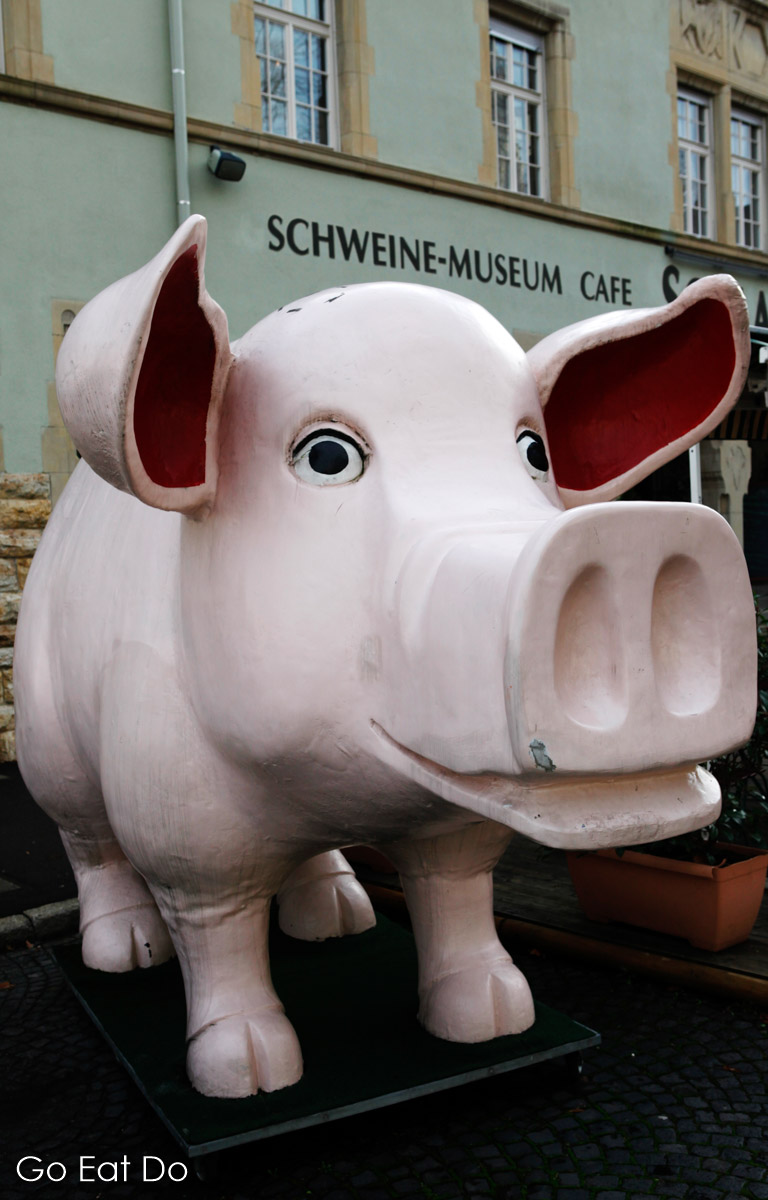
Displays in the Pig Museum Stuttgart
Informative displays in the SchweineMuseum provide insights into the history of human interactions with pigs. People have kept pigs for 9,000 years, according to evidence discovered by archaeologists in Turkey. The presence of the animal around the world means that it features in many cultures and mythologies.
Artefacts on display include books, comics, toys and even clothing. Piggybanks, it turns out, may date back to the 13th century. One of that age was found in Billeben in the German state of Thuringia.
I’m fascinated to learn that Steiff, the toy manufacturer today best known for their teddy bears, was marketing cuddly pig toys in 1892. That was ten years before the availability of their first teddy.
Why not go the whole hog and have a drink and bite to eat in the Schlachthof while you’re in this part of the city?

Map of the SchweineMuseum Stuttgart
The map below shows the location of the SchweineMuseum Stuttgart:
Getting to the SchweineMuseum Stuttgart
Travelling to the SchweineMuseum Stuttgart on public transport? The nearest bus and U-Bahn stations (Schlachthof) are a just couple of minutes’ walk from the museum. The ride on the U9 from the central station (Hauptbahnhof) takes eight minutes.
Onsite parking is available at Stuttgart’s Pig Museum.
Travel to Stuttgart
Stuttgart Airport is 13 kilometres (eight miles) south of the city centre. The S2 and S3 S-Bahn lines connect the city and airport in a little under 30 minutes.
Stuttgart Hauptbahnhof offers national and international train connections.
Hotels in Stuttgart Germany
Planning a trip to Baden-Württemberg’s state capital? Search for hotels in Stuttgart via Booking.com:
Books about Germany
Planning a trip to Germany or find pigs fascinating? You may find the following books useful:
DK Eyewitness Germany travel guide:



Communist Pigs: An Animal History of East Germany’s Rise and Fall by Thomas Fleischman:

Further information
Stuttgart’s SchweineMuseum (Schlachthofstrasse 2a, 70188 Stuttgart, tel. + 49 711 66419 600) is in the city’s Old Slaughterhouse. See the museum’s website for more information including up-to-date details about opening times, entry prices and special exhibitions.
See the Stuttgart Tourism website for more on the city and region and the Germany National Tourist Board site for travel ideas further afield.
Stuart Forster, the author of this post, is an award-winning travel writer who speaks fluent German.
Thank you for visiting Go Eat Do and reading this post about Germany’s Pig Museum, the SchweineMuseum Stuttgart.
If you enjoyed this post please sign up for the free Go Eat Do newsletter? It’s a hassle-free way of getting links to posts on a monthly basis.
‘Like’ the Go Eat Do Facebook page to see more photos and content.
A version of this post was initially published on Go Eat Do on 5 January 2015.
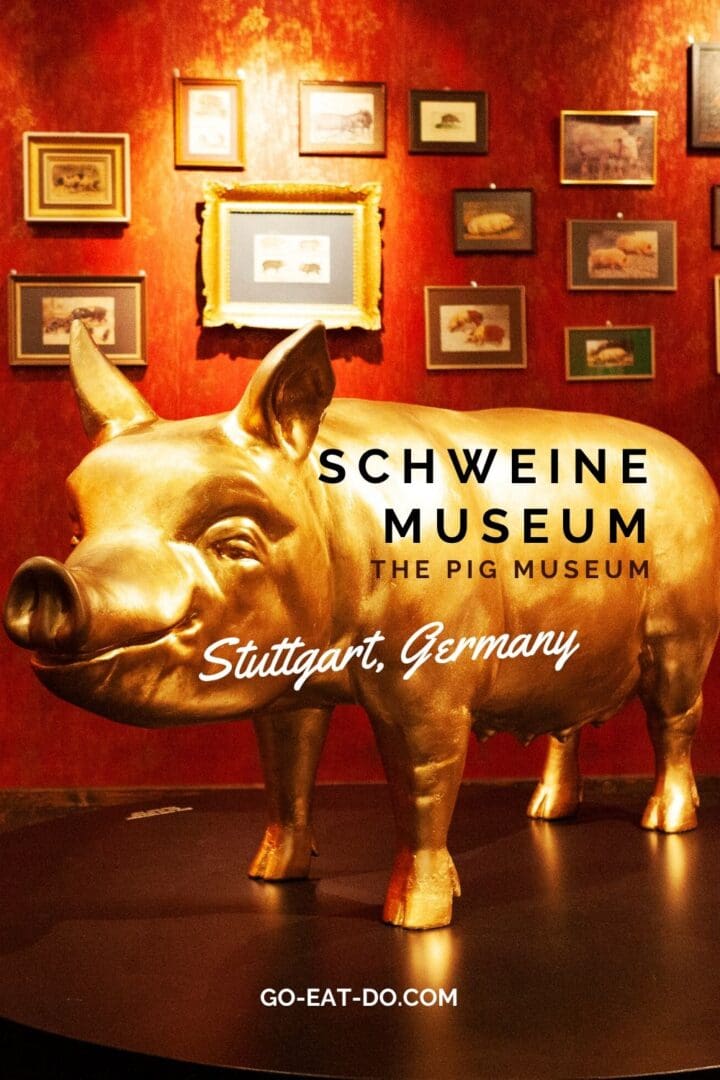



Roger Giford
January 12, 2015 at 19:39I presume you have some of the Piggin’ range of figurines from England based on the north of England phrase of Piggin’ this and that I have a small collection before they began making my front room look like a piggery If I by some miracle came back to stuttgart I would defenitely visit unfortunately I am now severley disabled and semi-housebound
Stuart
January 14, 2015 at 12:03Thanks for your comment. I have to admit I haven’t heard of them but I have seen the Natwest collection of piggy banks. Best wishes, Stuart